Victoria Fox's Blog, page 219
July 2, 2023
The Empire Strikes Back’s Battle Of Hoth Had The Help Of The US Army

Burtt went on an extended excursion to various military bases where he knew weapons were being tested and carried along his recorder. According to this interview, he was able to capture plenty of explosions and firearms that would eventually be remixed into the weapons fire for his sci-fi picture. He was essentially allowed to build his own sound effects library that was unique to “The Empire Strikes Back.” In Burtt’s words:
“We spent two weeks going out with the US Army to record all of their weapons. It was like being in basic training, except I didn’t have to take orders. The Pentagon Department of Defense arranged for us to travel around and go to different army bases where we did lots of weapons — artillery, small arms, shoulder-launched missiles. And all of that munition — the ricochets, the bullet fly-bys, explosions — became the core material for the snow battle.”
Of course, it wasn’t just a matter of recording explosives and firearms, but distorting the audio in a way that would make them sound distinctly “Star Wars”-like. In one instance, he slowed down the sound of a bullet bouncing off of a metal plate and morphed it into a fantasy laser blast. Yes, he had to get close. No, it wasn’t safe. He knew that. Burtt said:
“You could take a ricochet of a bullet that we recorded and you could slow it down to become a really interesting laser, or an ion cannon or something like that. […] But looking back at it, you’d be hard-pressed to get that kind of open access today to military activity because of the liability. […] We had some close calls, where bullets were hitting the ground near us and passing overhead. But we got some good sounds!”
Imax Partners with Chinese Studio on Nature Doc ‘The Elephant Odyssey’

Imax has boarded production on a new nature documentary, The Elephant Odyssey, chronicling 16 wild Asian elephants’ improbable journey across China’s Yunan Province. Filmed with Imax cameras and slated for release across the Imax theater network in 2024, the 90-minute documentary is currently in production in China. Co-producers with Imax are Singapore’s Beach House Pictures and a Beijing-based company called China Review Studio of China International Communications Group.
The producers say the film will offer “a completely new story on humanity’s relationship with the elephant” with a narrative built around the real-life story that unfolded in 2020 when a group of wild Asian elephants left their habitat in China’s Xishuangbanna National Nature Reserve. The elephants’ journey was captured by drone cameras and live-streamed, captivating viewers in China and elsewhere. For 18 months, the elephants traveled over 1000 kilometers (over 620 miles) on a wildlife journey that included “impromptu village feasts, riotous raids on grain stores, messy mud fights and even giving birth on the road.”
Related Stories“The 18-month journey of the Yunnan elephants at the height of the pandemic was a hopeful antidote to the lockdowns many of us were enduring,” said John Turner, head of documentaries for Imax. “We wanted to know more about these animals and why it happened.”
The film is directed by filmmaker Alice Gu (The Donut King) with Clair Popkin (Free Solo) serving as the director of photography. Imax’s John Turner and Daniel Manwaring, Beach House’s Donovan Chan and Jocelyn Little, and China Review Studio’s Chen Fang executive produce.
Added China Review Studio’s director, Chen: “The Elephant Odyssey is a deep exploration that goes beyond the fascinating journey of the Asian elephants that moved north and south, uncovering previously unknown, touching stories. We very much look forward to telling a distinctive Chinese story to audiences worldwide, together with Imax and Beach House Pictures.”
All Five Indiana Jones Movies Ranked, Including ‘Dial of Destiny’
With the release of Harrison Ford’s final Indiana Jones film, The Dial of Destiny, the saga is officially over. But before we put all five movies in a museum, let’s take a look back. Below The Hollywood Reporter ranks Dr. Jones’ adventures from the worst to the best. It’s a franchise that helped define the summer blockbuster and represented some of the top work of creators George Lucas, Steven Spielberg and Ford — who will probably be forever more closely identified with his intrepid archaeologist than any other character from his career.
Still, since we’re starting at the bottom, that can only mean that we must first discuss…
Related Stories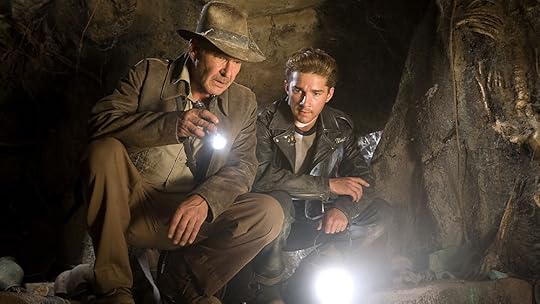 Harrison Ford and Shia LaBeouf in ‘Indiana Jones and the Kingdom of the Crystal Skull’ Paramount/Courtesy of Everett Collection 5. The Kingdom of the Crystal Skull (2008)
Harrison Ford and Shia LaBeouf in ‘Indiana Jones and the Kingdom of the Crystal Skull’ Paramount/Courtesy of Everett Collection 5. The Kingdom of the Crystal Skull (2008)A hokey ramshackle mess. Everything about the fourth film feels weirdly distant and off somehow. Even the glossy cinematography by the usually stellar Janusz Kaminski manages to make scenes that were shot outdoors look like they’re inside a studio, while the less that’s said about Indy’s son Mutt (Shia LaBeouf) and his Tarzan swing the better (in fairness to LaBeouf, one suspects no actor could have made his character work as written). In other Indy movies, you try to pick out the best sequence; here it’s a fight for the worst (most pick the “nuke the fridge” scene; my choice is the cemetery brawl with the parkour warriors). An Indy film’s MacGuffin might not be the most important element, but it’s not unimportant either, and Dr. Jones’ quest for an alien artifact leads to a groaner of climactic sequence and some franchise-worst CG to top it all off. It’s the only film of the five that feels like a slog.
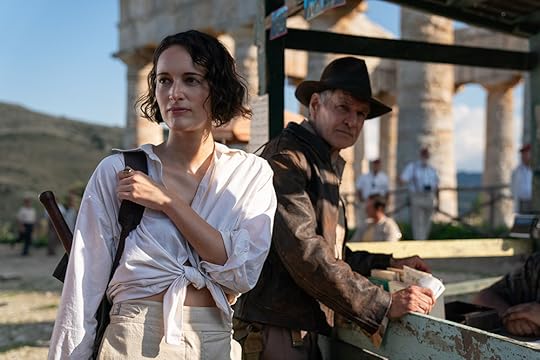 Lucasfilm 4. The Dial of Destiny (2023)
Lucasfilm 4. The Dial of Destiny (2023)Not as bad as the Cannes buzz suggested, yet not nearly as good as fans had hoped, Dial of Destiny represents a clear step up from Crystal Skull while still ranking miles below the original trilogy. The de-aged Indy opening sequence is surprisingly decent (Ford’s gravely voice couldn’t be de-aged as well as his face) and the film effectively shuffles along for most of its run, with Phoebe Waller-Bridge bringing some bright energy as Indy’s goddaughter Helena Shaw and Mads Mikkelsen ever-watchable as villain Jürgen Voller. Ford is compelling when he’s given something to do, though Indy also feels like a frustratingly passive character at times. Then comes the derailment: After two hours of teasing the idea of Indiana Jones traveling back in time, the payoff is stupefying and disappointing. Instead of revisiting, for instance, a moment in Indy’s storied past — it’s so easy to imagine Voller wanting to use the Dial to get the Ark of the Covenant during Indy’s Raiders adventure, or the Holy Grail during Last Crusade, to accomplish his goal of helping the Nazis win World War II — we instead are transported to an ancient Roman battle the audience doesn’t care about. Even Voller’s stated plan of returning to 1939 is more exciting than what the film did instead. Ultimately, Indy is left in a fine enough place, yet one wishes the filmmakers could use a Dial of Destiny to go back and rework the film’s third act.
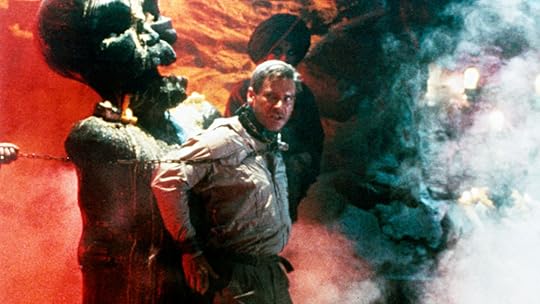 Paramount/Courtesy of Everett Collection 3. The Temple of Doom (1984)
Paramount/Courtesy of Everett Collection 3. The Temple of Doom (1984)Temple of Doom has been criticized (including by Lucas and Spielberg) as being overly dark (its release helped inspire the PG-13 rating), and there are indeed moments that feel like they cross the line for what these movies are supposed to be (like that whipping scene). It’s also been justifiably criticized as leaning heavily on offensive racial stereotypes as Indy stumbles onto a child-enslaving Thuggee cult in India. Many also find Kate Capshaw’s shrieking Willie Scott off-putting. It’s tough to transition from all these elements to an “and yet …” but … and yet .. when the film works, it has some of the best sequences in the franchise: The nightclub negotiation, the raft escape from a crashing plane, the will-they-or-won’t-they seduction scene, the spike room, the climactic bridge showdown — they’re all terrific, and Ke Huy Quan’s Short Round is occasionally winsome. (Admittedly helping matters: Ford is peak Sexy Indy in this one).
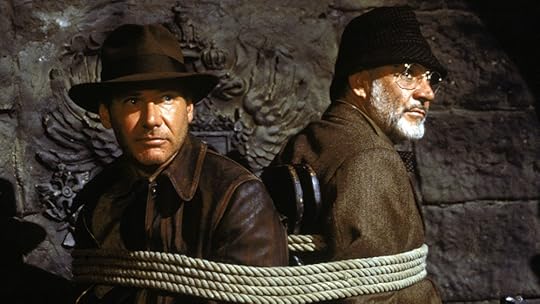 Paramount/Courtesy of Everett Collection 2. The Last Crusade (1989)
Paramount/Courtesy of Everett Collection 2. The Last Crusade (1989)The Last Crusade is many Indy fans favorite of the bunch, and it’s easy to see why. The film is a delight — the warmest and funniest in the franchise — with a deft and witty script by Jeffrey Boam. Sean Connery is spot-on as Indy’s father, Henry Jones, and their interplay is at turns playful and touching (after Henry uses his umbrella to compel birds to strike an attacking fighter plane, the expression of Indy’s face as he’s silently overwhelmed by unexpected love for his father gets me every time). The score is one of John Williams’ best. The Last Crusade also has arguably the strongest ending in the franchise, with its three challenge booby traps and a feeling of genuine urgency with Henry’s life on the line (even factoring the ridiculousness of the Crusade Knight — the film is a bit goofy at times). Henry calling his son “Indiana” for the first time and gently telling him to let the Holy Grail go is one of the saga’s finest beats, and their extended sunset ride over the closing credits is such an ideal and gorgeous ending that arguably nobody should have attempted to make another Indiana Jones film after this one.
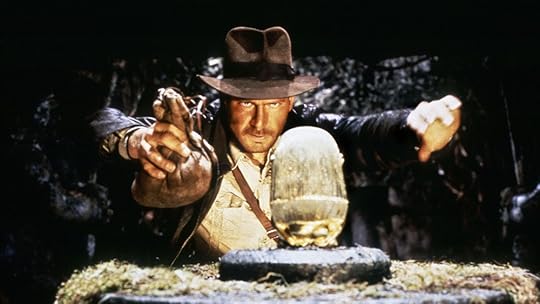 Paramount/Courtesy of Everett Collection 1. Raiders of the Lost Ark
Paramount/Courtesy of Everett Collection 1. Raiders of the Lost ArkRaiders of the Lost Ark is the closest you can find to a perfect action film. After 1941 bombed spectacularly, Spielberg was out to re-prove himself to Hollywood and it shows: Every scene is impeccable, starting with the opening temple raid that became one of the most iconic (and parodied) sequences in movie history. Ford deftly balances seriousness and humor, demonstrating at turns competence and fallibility, as Indy struggles — and fails, time and time again — yet stubbornly refuses to quit. There are so many moments one could single out. The lecture hall scene is a master class in delivering a lot of exposition in a compelling way (credit to screenwriter Lawrence Kasdan). The map room scene manages to kept the audience enthralled by simply watching Ford spend four minutes figuring something out — nearly all the storytelling is done on his face. Karen Allen’s Marion Ravenwood was ahead of her time as strong action co-lead. And the truck chase remains one of the best stunt sequences ever shot. (What does it say about the evolution of Hollywood filmmaking that the Indy film made with practical effects — aside from some dated climactic animation — and the least amount of money — $20 million/$78 million with inflation — visually remains the franchise’s strongest and most grounded-looking entry?). Clearly, top men — and women — were working on this one.
Christine Vachon on the State of Indie Film and Why She Loves Working With First-Time Directors “Making the Story They Really Want to Tell”

Christine Vachon’s work at Killer Films, the state of independent film and working with first-time directors were among the topics addressed by the veteran indie film producer during a tribute dinner in her honor at the 57th Karlovy Vary International Film Festival on Sunday.
With this year’s edition of the big Czech cinema fest paying homage to her, Vachon shared insights and anecdotes with an audience of select guests dressed in cocktail attire at the spa town’s Grandhotel Pupp. The hotel served as a location for James Bond film Casino Royale (in which it was featured as Hotel Splendide) and has been cited as the inspiration for the Grand Budapest Hotel in the Wes Anderson movie of the same name.
Related StoriesSeveral questions during a brief conversation at the start of the event focused on Vachon’s priorities and the work of her Killer Films production company. “We are known for working with first-time directors, and that is something that I really love to do,” Vachon shared. “It’s really easy to get very cynical in this business, and this cynicism is incredibly destructive. First-time directors tend to be making the story they really want to tell, and their joy … in what they do is something that gets me excited.”
When asked about the Killer Films brand, Vachon mentioned that the company makes movies that “we feel are truly original, provocative and really have something to say,” also noting that the different tastes that she and co-founder Pamela Koffler bring to the table ensure “varied projects.” Her conclusion: “I feel what we do is very eclectic.”
Expanding on the difference in taste between the two partners, she explained, “Our tastes are different enough. I don’t think it’s so great to work with somebody who has identical taste, because, you know, why bother?”
Asked about the state of the indie film space and whether it faces extinction, Vachon responded, “A lot of people have been dancing on the grave of independent film for a really long time,” arguing, “It certainly hasn’t gotten harder to create content necessarily.”
Vachon acknowledged, though, that independent film was facing key questions that the whole industry is discussing: “What is the future of theatrical? What does that mean for the kinds of stories you want to tell?” Her conclusion: “What we are really looking at now is what’s going to happen to adult-driven drama? And have people simply decided that they’d rather watch that at home? And what gives something that sense of urgency to send you to the theater to see it?”
Asking Vachon questions on Sunday night was Leo Barraclough, writer at Variety, which, just like The Hollywood Reporter, is owned by Penske Media Corporation.
A broader audience will get to enjoy hearing from Vachon during a masterclass on Monday that is part of the second day of the Karlovy Vary Festival’s Eastern Promises Industry Days program.
Vachon is not the only big name getting put into the spotlight by the festival. Russell Crowe, Alicia Vikander and Ewan McGregor have already been honored with lifetime achievement awards over the course of the first couple of days of this year’s edition.
Robin Wright will follow at the end of the 2023 event. The Karlovy Vary Film Festival runs through July 8.
China Box Office: ‘Indiana Jones 5’ Bombs With $2.3M Opening
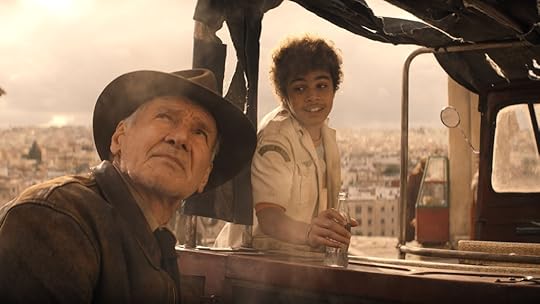
Indiana Jones and the Dial of Destiny may have opened soft in North America with $60 million, but it outright bombed in China, where filmgoers have little to no emotional connection to the classic adventure franchise.
Expectations for the Disney and Lucasfilm tentpole were always low in China, but the film’s $2.3 million opening from Friday to Sunday is on the far low end of most analysts’ already low forecasts. None of the first four films in the Indiana Jones franchise were distributed in China, so the country’s geriatric millennials — not to mention its Gen Zs and below — have little to no nostalgic connection to Harrison Ford’s octogenarian hero.
Related StoriesDial of Destiny has been relatively well-liked by those who have seen and rated it in China. It currently has respectable social scores of 8.8 from the ticketing app Maoyan, 8.9 on Alibaba’s Taopiaopiao and 7.3 on Douban. Nonetheless, Maoyan projects the film to top out in China with just $3.8 million. With a hefty $295 million production budget before marketing, Dial of Destiny is the most expensive U.S. studio tentpole to perform that poorly in China.
The top spots at the box office over the weekend were held by local Chinese hits — continuing a growing trend of domestic fare far out-performing imported Hollywood movies in the market.
Mystery thriller Lost in the Stars, produced and written by local hitmaker Chen Sicheng (Detective Chinatown), was again dominant in its second weekend, surpassing its opening with a $116.8 million haul from Friday to Sunday, according to data from Artisan Gateway. After 11 days on screens, the film, distributed by Alibaba Pictures, has earned a whopping $319.6 million. Maoyan forecasts it to finish with over $450 million.
Second place went to Never Say Never, directed by and starring Wang Baoqiang (Detective Chinatown, Lost in Thailand). The inspirational fight film is based on a true story about a retired armed Chinese police officer who opened a mixed martial arts club in Sichuan Province, training orphans into champion fighters. The film technically doesn’t release until July 6, but it has received expansive “preview screenings,” earning $25.6 million over the weekend for a total of $38.9 million to date.
Love Never Ends, a romance about elder love starring veteran actors Ni Dahong, Kara Wai, Tony Leung and Ye Tong, slipped to third place with $10.7 million. After two frames, its total sits at $45 million, a healthy haul given its subject matter.
Local titles will have free rein in China over the next two weeks until Paramount’s Mission: Impossible – Dead Reckoning Part One opens on July 14.
Lawrence Turman, Oscar-Nominated Producer of ‘The Graduate,’ Dies at 96

Lawrence Turman, the principled Oscar-nominated producer of The Graduate who was behind other films including The Great White Hope, Pretty Poison, American History X and the last movie Judy Garland ever made, has died. He was 96.
Turman died Saturday at the Motion Picture & Television Country House and Hospital in Woodland Hills, his family announced.
A former agent, he and producer David Foster began a 20-year partnership in 1974, and the first film to come out of the Turman Foster Co. was Stuart Rosenberg’s The Drowning Pool (1975), starring Paul Newman and Joanne Woodward.
They went their separate ways in 1991 when Turman left to begin a long association heading the esteemed Peter Stark Producing Program at USC that lasted until his retirement in 2021.
However, Turman wasn’t done producing, and in 1996 he and John Morrissey launched the Turman-Morrissey Co., which made the Jamie Foxx-starring Booty Call (1997); Tony Kaye’s American History X (1998), starring Edward Norton in an Oscar-nominated turn as a neo-Nazi; and the LL Cool J comedy Kingdom Come (2001).
Turman also directed two features, both of which he produced as well: The Marriage of a Young Stockbroker (1971), starring Richard Benjamin, and Second Thoughts (1983), starring Lucie Arnaz.
Turman produced more than 30 movies and nearly a dozen teleflms during his career. “I initiate every single film project upon which I work; most of them would not have seen the light of day had I not decided to make them,” he wrote in his 2005 book, So You Want to Be a Producer. “I’m the starter and also the finisher.”
A member of the Producers Guild of America Hall of Fame, Turman knew that someone in his profession should never spend his own money to make a picture, but that’s exactly what he did in 1963, forking over $1,000 to option The Graduate after reading a review of Charles Webb’s first novel in The New York Times.
Related StoriesHe needed a director next and zeroed in on Mike Nichols; Elaine May’s former comedy partner had never helmed a movie, but he was coming off a lengthy run on Broadway with Neil Simon’s Barefoot in the Park, starring Robert Redford and Elizabeth Ashley.
“Mike Nichols was an intuitive hunch,” Turman told Vanity Fair in 2008. “Webb’s book is funny but mordant. Nichols and May’s humor seemed like a hand-in-glove fit to me.”
He told Nichols: “I have the book, but I don’t have any money. I don’t have any studio. I have nothing, so let’s do this. We’ll make this movie together, and whatever money comes in, we’ll split 50-50.” The director signed on right away.
After being turned down by every major studio for two years — Nichols had directed Who’s Afraid of Virginia Woolf? and received an Oscar nomination in the interim — Turman got Joseph E. Levine at Embassy Pictures to bankroll The Graduate after he promised he could make it for $1 million.
When Turman and Nichols were unhappy with Calder Willingham’s too-dark script, they gave the untested Buck Henry a crack at it.
Nichols then cast the unknown Dustin Hoffman as a recent college graduate who has an affair with the wife of his father’s business partner, and The Graduate, which cost $3 million in the end, raked in $35 million in its first six months en route to becoming the highest-grossing film of 1967.
It was nominated for seven Oscars, but only Nichols won. (It lost the best picture race to In the Heat of the Night.)
“I was famous after The Graduate for about 20 minutes,” Turman said in a 2017 interview. “It’s nice to get a better table at the restaurant, but basically, that doesn’t motivate me.
“I never even thought about fame. I was inundated with telephone calls and letters and scripts after the film’s success. That’s Hollywood. Fame is ephemeral and gives us life. I was asked to run a few studios, be head of production. But that lasted for nearly a year, then the next flavor-of-the-month producer would come through.”
Born at Cedars of Lebanon hospital in Los Angeles on Nov. 28, 1926, Turman graduated from Los Angeles High School, where he was all-city in basketball and sports editor of the paper, and UCLA. He spent two years in the U.S. Navy as an enlisted man, then went to work for his father in the textile business, even though he always wanted to be a Hollywood producer.
“Everyone always says how tough showbiz is,” Turman told Vanity Fair, “and, of course, they’re right, but it’s kid stuff compared to the garment business, where someone will cut your heart out for a quarter-cent a yard. I’d carry bolts of cloth five blocks after making a sale, only to learn that the customer bought it cheaper, and I had to schlep the bolts of cloth back to my dad’s office.”
After interviews with producers Jerry Wald and David Lewis and agent Sam Jaffe went nowhere, Turman answered a blind ad in Variety and was hired at the Kurt Frings Agency for $50 a week. He eventually became an agent, representing Joan Fontaine and Alan J. Pakula, among others. (He once got four clients into Alfred Hitchcock’s North by Northwest.)
During his four-year stint as an agent, “I was a sponge; I soaked up everything,” he wrote in his book. “I learned who’s who and how Hollywood works. I met everybody I could, which ended up being helpful in ways I didn’t imagine at the time.”
He left the agency after getting an offer to produce with Stuart Millar the Fredric March-Ben Gazzara melodrama The Young Doctors (1961).
They also worked together on I Could Go on Singing (1963), starring the troubled Garland in her final film — Turman called her a “gray-hair giver” — Susan Hayward’s Stolen Hours (1963) and Gore Vidal’s political drama The Best Man (1964), starring Henry Fonda and Cliff Robertson, before Turman dissolved the partnership.
While trying to get The Graduate together, he produced Irvin Kershner’s The Flim-Flam Man (1967), starring George C. Scott, followed by the Lorenzo Semple-penned Pretty Poison (1968), starring Anthony Perkins and Tuesday Weld, and the film version of The Great White Hope (1970), featuring the stars of the Broadway production, James Earl Jones and Jane Alexander.
Turman first met Foster when he hired him as a publicist on The Graduate, and the two enjoyed a fruitful partnership, with films including Heroes (1977), Caveman (1981), John Carpenter’s The Thing (1982), Running Scared (1986), Short Circuit (1986), Gleaming the Cube (1989) and The River Wild (1994).
“Larry is the opera and the symphony,” Foster told the Los Angeles Times in 1994. “I like to go to the football game and scream and carry on.”
Wrote Turman in his book: “We were complementary, not supplementary. He gravitated toward action and size — Running Scared and the [1994] remake of The Getaway — while I’ve always been attracted to more intimate, emotional stories like [1984’s] Mass Appeal or [1980’s] Tribute. I felt that my strength was in script and editing, whereas his was in marketing and relationships.”
He and Morrissey worked together at Rastar Pictures before setting up their own shop.
Survivors include his sons, John, a co-screenwriter on 2003’s Hulk; Andrew, a camera operator and cinematographer; and Peter, a realtor; daughters-in-law Analuisa, Nancy and Sheri; grandchildren Audrey, Carter, Georgia and Olivia; and nieces Katherine and Suzanna.
A service will be held at the Motion Picture home at a date to be determined. A donation in his name can be made to The Larry Turman Endowed Fund for the Peter Stark Program — USC School of Cinematic Arts.
As a producer, Turman “strongly believed in writers and enjoyed working with them, respecting their foundational value,” his family noted.
“He maintained many friendships with some of the greats. His correspondences show a back and forth with friend William Goldman as Turman was trying to get The Graduate made and Goldman was writing Butch Cassidy and the Sundance Kid, each in their own way trying to capture the voice of their generation. Initially planning to produce Butch Cassidy, Turman stepped back so that Goldman could get the attachments to get the film made with Newman and Redford.
“His passing notes a truly golden era of Hollywood filmmaking.”
NY may require businesses near Ground Zero during 9/11 to inform workers of toxins, benefit eligibility
The new legislation will require businesses in lower Manhattan and northern Brooklyn during Sept. 11, 2001, terror attacks to contact workers employed during that time who may have been exposed to life-threatening toxins.
The 9/11 Notice Act was unanimously passed by both the state Assembly and Senate.
Governor Kathy Hochul is reviewing the bill and will likely approve it before the 9/11 anniversary. It hasn’t yet been sent to her desk.
Assemblyman Nader Sayegh (D-Yonkers) said he drafted the legislation following the 20th anniversary of the 9/11 terrorist attacks.
Sayegh said he was spurred into action after learning that of the 400,000 civilians exposed to 9/11 toxins, only a small percentage with qualifying medical conditions had registered for the 9/11 Victim Compensation Fund and the World Trade Center Health Program.
Both provide free monitoring and treatment for eligible individuals with WTC-related illnesses.
 Assemblyman Nader Sayegh (D-Yonkers) said he drafted the new legislation following the 20th anniversary of the 9/11 terrorist attacks.
Assemblyman Nader Sayegh (D-Yonkers) said he drafted the new legislation following the 20th anniversary of the 9/11 terrorist attacks.Nader Sayegh
 The new legislation will require businesses in lower Manhattan and northern Brooklyn during Sept. 11, 2001, to contact workers employed during that time who may have been exposed to life-threatening toxins. Getty Images
The new legislation will require businesses in lower Manhattan and northern Brooklyn during Sept. 11, 2001, to contact workers employed during that time who may have been exposed to life-threatening toxins. Getty ImagesBy comparison, more than 80% of first responders have registered with the federal health and compensation programs.
Under the measure, employees who worked near Ground Zero between September 2001 and the end of May 2002 need to be contacted by their employers and former employers and made aware of their right to seek medical compensation.
“It is nearly 22 years after the terrorist attacks and an utter lack of awareness about the benefits and eligibility for the federal World Trade Center Health Program and 9/11 Victim Compensation Fund means we needed to act,” Sayegh said.
 The World Trade Center was hit by two planes on September 11, 2001, in New York City. Getty Images
The World Trade Center was hit by two planes on September 11, 2001, in New York City. Getty Images  Pedestrians were pictured running away as the Twin Towers were collapsing in NYC.AFP via Getty Images
Pedestrians were pictured running away as the Twin Towers were collapsing in NYC.AFP via Getty Images“The 9/11 Notice Act means that forgotten victims, including downtown office workers, doormen, construction workers, students, teachers, retail workers, and delivery people, must be notified of their eligibility status by their ex-employer. No one should be left to suffer from 9/11-related illness and be burdened with overwhelming medical bills when the federal resources are FREE and available to help them.”
Sen. Brian Kavanagh (D-Manhattan), who shepherded the bill through the upper house and whose district includes the World Trade Center site and is home to many 9/11 survivors, said many people “may be experiencing WTC-related illnesses and may be eligible for financial and healthcare benefits, but may not realize that they are.”
The Post has reported numerous cases of people — students as well as workers and first responders– stricken with cancers and other illnesses after being exposed to toxins following the collapse of the World Trade Center towers.
 The 9/11 Notice Act was unanimously passed by both the state Assembly and Senate.Getty Images
The 9/11 Notice Act was unanimously passed by both the state Assembly and Senate.Getty Images  Sayegh said he learned 400,000 civilians were exposed to 9/11 toxins, but only a small percentage with qualifying medical conditions had registered for the 9/11 Victim Compensation Fund.
Sayegh said he learned 400,000 civilians were exposed to 9/11 toxins, but only a small percentage with qualifying medical conditions had registered for the 9/11 Victim Compensation Fund.Getty Images
Freak illnesses include men who got breast cancer.
Of the 400,000 people exposed to Ground Zero toxins on 9/11 and afterward, 57,000 were residents south of Canal Street, as well as 15,000 students and staffers at downtown Manhattan schools, like Stuyvesant High School.
Assemblyman Gary Pretlow (D Mount Vernon) said more people have died from 9/11 health-related illnesses — nearly 6,000 — than the 2,977 victims killed that day.
“I will never forget the smell of burning metal and the sight of the chalky dust cloud that engulfed Lower Manhattan after the terrorist attack on 9/11,” he recounted. “More than two decades later, the potent smell and powdery dust are gone; however, the effects of the toxins still linger, causing more than 5,891 deaths since 9/11—more than the death toll on that terrible day.”
 The Post has reported numerous cases of people, including students, workers, and first responders, stricken with cancers and other illnesses after being exposed to toxins following the collapse.
The Post has reported numerous cases of people, including students, workers, and first responders, stricken with cancers and other illnesses after being exposed to toxins following the collapse.AFP via Getty Images
Tommy Steed, Chairman of the Association of BellTel Retirees, representing 134,000 retirees from Verizon, AT&T, and Empire City Subway, noted many who toiled in Ground Zero to repair communication lines after the terrorists attacked.
“Land lines were dead, cell phones had no signals, high-speed data could not transmit and federal, state, and regional first responders lacked a reliable means to connect,” he said.
“It was our members who were called in on Day 1, to restore service in Lower Manhattan and for the reopening of the financial markets. What we didn’t plan for was being exposed to the world’s largest and most toxic burn pit.”
Indiana Jones And The Dial Of Destiny’s Truly Crazy Final Act Is Based On Actual History

Let’s start with the artifact, shall we? The real Antikythera is believed to be a hand-powered orrery — a model of the Solar System that shows the positions of the planets and moons and predicts their movements. It is described as the first analog computer, but the mechanism’s true purpose and its inner-workings continue to baffle scientists.
If you don’t know who he was, Archimedes was a Greek engineer, mathematician, inventor, and astronomer from the ancient city of Syracuse, in what is now Sicily. To avoid giving a whole lecture, Archimedes was considered one of the greatest mathematicians of all time, and a brilliant mind. One of his inventions, the Archimedes screw, continues to be used today to pump water, while his contributions to mathematics, like calculating the area of a circle to the volume of a sphere and were influential in the Renaissance once his surviving work was rediscovered.
Though it is believed that Archimedes did not build the Antikythera, he very much existed and could have created the designs and work that eventually led to the device. Archimedes also aided his home city by creating weapons of war that aided against the invaders from the Roman Republic in 213 and 212 BC. Arguably his best known contribution n battle was his idea for a heat ray (it may or may not have actually worked) that used mirrors to redirect sunlight to incoming ships and burn them down.
Archimedes died during the siege of Syracuse by the Roman Republic in 212 BC, where it is said that the mathematician was so focused on his work that he ignored orders to leave the town and was killed by a Roman soldier who did not recognize the mathematician, despite direct orders not to kill him.
July 1, 2023
These are the most dangerous software security flaws of the year – are you at risk?

The Mitre Corporation released its annual list of the most dangerous software flaws for 2023, and there’s been no change at the top spot.
The American not-for-profit organization has been analyzing public vulnerability data found in the National Vulnerability Database (NVD) for root cause mappings to CVE weaknesses for the past two years. During that time, the organization analyzed almost 44,000 CVEs.
As per the analysis, out-of-bounds write flaw is the most dangerous software vulnerability for the year (as was for the year 2022). This is a type of software flaw that sees a program write outside the bounds of an allocated area of memory. As a result, the endpoint might crash, or execute arbitrary code. Threat actors usually abuse this flaw by writing data that’s larger in size than the size of the allocated memory area, or by writing the data to an incorrect location within the memory area.
The prevention of out-of-bounds write flaws usually includes careful validation of all inputs, to make sure they’re within the expected range.
Other major software vulnerabilities include cross-site scripting (XSS), SQL injection, use after free, OS command injection, improper input validation, out of bounds read, path traversal, cross-site request forgery (CSRF), and unrestricted upload of file with dangerous type. The biggest change, compared to last year, is the exclusion of improper restriction of XML external entity reference, which is no longer considered among the top 25 most dangerous flaws.
Analysis: Why does it matter?Software flaws such as these ones can be leveraged by threat actors for all kinds of cyberattacks. They can be used to steal sensitive data, take over vulnerable endpoints, engage in identity theft, wire fraud, and more. For example, cybersecurity researchers Francisco Falcon and Ivan Arce discovered out-of-bounds read (CVE-2023-1017) and out-of-bounds write (CVE-2023-1018) vulnerabilities in TPM 2.0, in early March 2023. Back then, it was said that the vulnerabilities could mean major trouble for “billions” of vulnerable devices.
“An attacker who has access to a TPM-command interface can send maliciously-crafted commands to the module and trigger these vulnerabilities,” CERT warned about the flaws at the time. “This allows either read-only access to sensitive data or overwriting of normally protected data that is only available to the TPM (e.g., cryptographic keys).”
A month later, in early April, Apple reportedly fixed an IOSurface out-of-bounds write vulnerability that allowed threat actors to corrupt data, crash apps, and devices, and remotely execute code. Worst case scenario – a threat actor could push a malicious app allowing them to execute arbitrary code with kernel privileges on the target endpoint. This app was used in the wild, Apple confirmed.
Popular instant messaging platform Telegram also wasn’t immune to out-of-bounds write flaws, as back in 2021, a security researcher discovered one such zero-day in a batch of 13 vulnerabilities.
Earlier this month, the Cybersecurity and Infrastructure Security Agency (CISA), and the U.S. National Security Agency (NSA) pushed a set of tips and best practices organizations can use to secure their Continuous Integration/Continuous Delivery (CI/CD) environments, The Hacker News also reported. As per the recommendations, businesses should implement strong cryptographic algorithms in their cloud app configurations, minimize the use of long-term credentials, and go for secure code signing. Furthermore, CISA states, businesses should utilize two-person rules when reviewing developer code commits, and adopt the principle of least privilege.
“By implementing the proposed mitigations, organizations can reduce the number of exploitation vectors into their CI/CD environments and create a challenging environment for the adversary to penetrate,” the two organizations stressed.
What have others said about it?“MITRE’s 2023 top 25 weaknesses are dangerous due to their significant impact and widespread occurrence in software released over the past two years,” says BleepingComputer in its writeup. “By sharing this list, MITRE provides the broader community with valuable information regarding the most critical software security weaknesses that require immediate attention.”
The Register, on the other hand, was traditionally more cynical in its report, stating “Cough, cough, use Rust.”
“The most dangerous type of software bug is the out-of-bounds write, according to MITRE this week. This type of flaw is responsible for 70 CVE-tagged holes in the US government’s list of known vulnerabilities that are under active attack and need to be patched,” it added, also stating that the fact that the same vulnerability is in the top spot for two years in a row signals a “distinct lack of improvement.”
Users on social media were somewhat less vocal, with the news flying under the radar on Reddit, while on Twitter one user stated: “First rule of programming…Don’t build your software on frameworks e.g. DotNet, Java, React, Node, JQuery or any other… Second rule of programming…Always use the native operating system’s API e.g. WIN32!”
Go deeperIf you want to learn more about staying safe online, start by reading our guide on the best antivirus programs, and our guide on the best firewalls right now. You should also check out what is 2FA, as well as our guide on the best ID theft protection solutions at the moment.
Via: The Hacker News
What Those Monkey Brains In Indiana Jones And The Temple Of Doom Were Really Made Of

In “Temple of Doom,” after Indiana Jones, Willie Scott, and Ke Huy Quan’s Short Round first arrive at Pankot Palace, they sit down to a large banquet, where Indy questions Roshan Seth’s Prime Minister Chattar Lal about the sinister Thuggee cult. As the conversation unfolds, a series of unusual dishes, designed to be as nauseating as possible are served, beginning with “Snake surprise” (the surprise is there’s more snakes inside). That’s followed by a tray of giant beetles before the servers bring out eyeball soup. The grand finale is, of course, severed monkey heads with their skulls handily cracked open to allow the dinner guests easy access to the “chilled monkey brains” inside.
And while Spielberg had made Kate Capshaw work with real bugs and snakes in other scenes, he stopped short of making his actors actually eat real creatures. In a making-of featurette, the filmmaker explained how he conceived of “a meal of the worst stuff you would never imagine eating as long as you would live.” And in order to bring that vision to life, he had his crew come up with various practical solutions.
For the soup, rubber eyes were glued to the bottom of the bowl and would float up to the top when Capshaw stirred the broth. Custard also came in handy, especially for the beetles, which were, according to The Prop Gallery, actually made of latex rubber with a detachable section that the crew could fill with the dessert. And for those all-important monkey brains, the crew once again used regular old custard mixed with raspberry sauce.
Victoria Fox's Blog
- Victoria Fox's profile
- 137 followers



